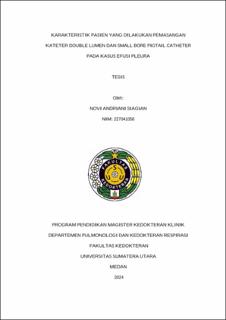| dc.description.abstract | Background: The incidence of pleural effusion in the United States is reported to be 1.3 million people annually. In Indonesia, the results of the prevalence of medical records on pleural effusion at H. Adam Malik Medan General Hospital in 2011 with 136 cases showed the prevalence of pleural effusion in women around 34.6% while in men around 65.4%. Several studies have suggested that the mortality rate of pleural effusion is quite high with malignancy being the most common cause of death. Tube thoracostomy remains the standard of care for the treatment of pneumothorax and simple effusions in most hospitals. Liu et al. (2010), reported a success rate of 64.0-81.6% in patients with different etiologies of pleural effusion, out of 276 patients using pigtail catheters. Basically, double-lumen catheters are more commonly used for the purpose of central venous catheterization with therapeutic or diagnostic purposes, so their use for pleural drainage is relatively uncommon in clinical practice.
Objective: to determine the characteristics of patients undergoing double lumen catheter and pigtail catheter insertion procedures for indications of pleural effusion.
Method: This study used a retrospective cross-sectional design. The study was conducted on adult patients who received double-lumen catheter and pigtail catheter insertion procedures for indications of pleural effusion based on the results of anamnesis, physical examination, radiological examination, and supporting examination at Prof. Chairuddin Panusunan Lubis Hospital (Prof. CPL Hospital), H. Adam Malik Central General Hospital Medan, and Elizabeth General Hospital Medan, Indonesia during the period September 2022 to April 2024.
Results: The majority of patients undergoing double lumen catheter insertion are female, whereas most patients with pigtail catheters are male. The average age of patients with double lumen catheters is 58.21 years, while patients with pigtail catheters have an average age of 54.9 years. Clinically, patients with double lumen catheters most frequently experience a combination of shortness of breath, cough, and chest pain. In contrast, patients with pigtail catheters most commonly report shortness of breath. Most patients with double lumen catheters suffer from lung malignancies, while patients with pigtail catheters also generally have lung malignancies, followed by lung infections and other issues. The type of pleural effusion fluid most frequently found in both patient groups is exudate. Radiologically, moderate pleural effusion is the most commonly observed condition in patients with both types of catheters. Thoracic ultrasound shows that most patients have a fluid volume between 500 and 2000 cc, regardless of whether they have a double lumen or pigtail catheter.
Conclusion: Both types of catheters can be used for malignant pleural effusion. Double lumen catheters are more often used in patients with moderate and massive pleural effusion, whereas pigtail catheters are more commonly used in patients with moderate pleural effusion. The appropriate choice of catheter depends significantly on the patient's condition, the cause of the pleural effusion, and radiological findings. | en_US |


